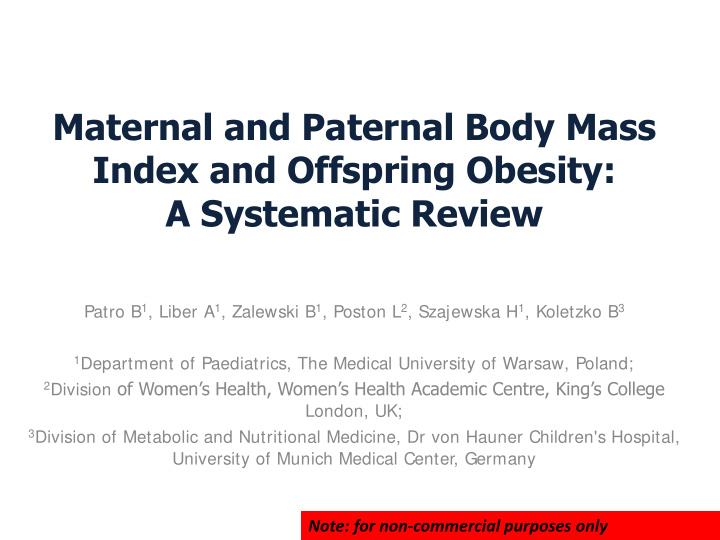



Maternal and Paternal Body Mass Index and Offspring Obesity: A Systematic Review Patro B 1 , Liber A 1 , Zalewski B 1 , Poston L 2 , Szajewska H 1 , Koletzko B 3 1 Department of Paediatrics, The Medical University of Warsaw, Poland; 2 Division of Women’s Health, Women’s Health Academic Centre, King’s College London, UK; 3 Division of Metabolic and Nutritional Medicine, Dr von Hauner Children's Hospital, University of Munich Medical Center, Germany Note: for non-commercial purposes only
Introduction- what is known? • High prevalence of overweight and obesity • The intrauterine environment as an important factor that influences the body mass index (BMI) and adiposity in later life • ‘ Fetal overnutrition hypothesis ’
Objective To test the following hypothesis : ‘ Paternal obesity /adiposity contributes equally to the obesity /adiposity of the offspring as compared to maternal obesity /adiposity assessed before pregnancy ’
Methods • A systematic review of observational studies • Sources of data: Electronic databases: - Medline - Embase - Cochrane Library Trial registries: - the ClinicalTrials.gov and the EU Clinical Trials Register website • The time frame of the search - March 2012
Methods – inclusion criteria (1) Type of participants • Parents-offspring trios • Offspring participants > 5 years of age
Methods – inclusion criteria (2) Type of exposure • Maternal BMI/adiposity measured before pregnancy or within the first trimester vs paternal BMI/adiposity analyzed in relation to offspring obesity/adiposity • Paternal measurements obtained not later than up until childbirth • Different ways of reporting participants weight and height
Methods – inclusion criteria (3) The primary outcome measure: • The association of offspring BMI/adiposity with pre-pregnancy BMI/adiposity of the mother, as well as BMI/adiposity of the father, and their relative contribution to explaining offspring BMI
Methods The secondary outcome measure: • Association of infant birth weight with pre-pregnancy BMI/adiposity of the mother, as well as BMI/adiposity of the father, and their relative contribution to explaining offspring birth weight • Association of infant adiposity with pre-pregnancy BMI of the mother and the father and their relative contribution to explaining offspring birth weight
Methods – exclusion criteria • Special populations • Prenatal parental measurements reported at the time of offspring assessment • Parental measurements obtained at the same time as offspring measurements • Primary outcome not assessed
Results Flow diagram of the study selection process
Results – included studies (1) 3 large birth cohorts : The Avon Longitudinal Study of Parents and Children (ALSPAC): Lawlor et al., 2008 Smith et al., 2007 Reilly et al., 2005 The Mater-University Study of Pregnancy (MUSP): Lawlor et al., 2007 O’Callaghan et al. ,1997 Northern Finland Birth Cohort: Jääskeläinen et al., 2011 - US parent-offspring trios: - Catalano et al., 2009
Results – included studies (2) • Design : prospective cohort studies • Population : general population from developed countries with the exception of the study by Catalano et al. • Offspring age at assessment : – ALSPAC: 7, 7.5 and 9-11 years – MUSP: 5-6 and 14 years – Finnish Cohort: 16 years – US parents-offspring trios: 6-11 years
Results – quality assessment (1) • Study design • Descriptive data • Measurements (units, methods) • Definitions of obesity and overweight • Statistics • Conflict of interest • Completeness of follow up • Controlling for confounding factors (CF), effect modifiers • Presentation of the results
Results – quality assessment (2) Sources of the potential risk of bias: • Indirect method of parental measurements • The role of CF • The issue of nonpaternity and not living with both biological parents
Results – primary outcomes Direct comparison of parent-offspring associations • Statistically stronger maternal influence found only in the MUSP cohort – The increase (in the fully adjusted model) in standardized offspring BMI for a 1 SD increase in maternal BMI vs paternal BMI: 0.362 SD (95% CI 0.323 – 0.402) vs 0.239 SD (95% CI 0.197 – 0.282) p <0.0001 • Equivocal results obtained from two studies describing the ALSPAC cohort
Results – primary outcomes Indirect comparison of parent-offspring associations The effect estimated based on the presented odds ratios: • The parental effect similar in the Finnish cohort • Some trend toward a stronger maternal effect in other studies with ALSPAC and MUSP data Maternal BMI as a stronger predictor of childhood obesity in 1 additional small study
Results – secondary outcomes • Only 1 study (MUSP) provided data on the associations of parental BMI with offspring birth size. • The maternal effect found to be stronger than the paternal effect (p < 0.0001) for all birth size outcomes.
Limitations • Methods of parental measurements The risk of recall bias ( mother’s prepregnancy weight) • • Dealing with CF and effect modifiers • The assumption that both mother and father contribute to the shared lifestyle between parents and offspring to a comparable extent • Unknown rate of overweight/obesity among parents • BMI as an estimate of childhood fat mass
Conclusions • Our findings provide limited evidence to support the tested hypothesis. • The review identifies a gap for further evidence of better quality rather than contradicting a role for the fetal overnutrition hypothesis in the current obesity epidemic.
Thank you!
Recommend
More recommend